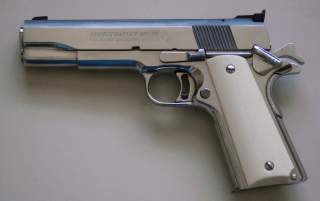This 100 Year Old Gun Might Out Last Any Glock or Sig Sauer
The 1911 soldiers on.
More than a century after its introduction, how much longer can the 1911 go on? As a pairing of high-powered bullet and frame, it’s difficult to beat. Other manufacturers including Glock and Springfield Armory have come out with competing .45 ACP designs that also have lasting appeal.
The 1911 is one of the most notorious handguns in history and easily the most famous in America, having seen action in every U.S. conflict since World War I. One of the most successful product designs ever, the 1911 has achieved something rare in the world of machines: immortality. Over a hundred years old, it remains largely unchanged.
What Apple is to consumer electronics, John Browning was to late 19th and early 20th century firearms. The 1911 is his most famous design. The typical 1911 is 8.25 inches from tip to tail and weighs 2.49 pounds empty — about as much as a trade paperback book. The 1911 is made of steel, steel and more steel, and takes a magazine that holds seven bullets.
The 1911 has seen service in World War I, Mexico, Haiti, Nicaragua, the Dominican Republic (twice), Lebanon, World War II, the Korean War, Vietnam, Iran, Grenada, Panama, the Gulf War, the Iraq War and Afghanistan. It has chased bad men from Pancho Villa to Osama Bin Laden.
Minor adjustments have been added here and there, but the general appearance and function of the gun has largely been left unchanged. The 1911 is the personification — among weapons, anyway — of what architect Louis Sullivan termed “form follow[ing] function.” The 1911 was not designed to be beautiful; it was designed to be useful. Ergonomically everything is where it should be for maximum efficiency.
The patent on the 1911 has expired and nearly every gun manufacturer churns out its own copy. The gun you buy today is more or less the exact same gun that was used by doughboys in the Meuse-Argonne in World War I, Army Rangers on D-Day in World War II, and went up Hamburger Hill in Vietnam. You can’t really buy a lot of things that were for sale in 1918 today — not that you would want to.
The 1911 comes from another time — arguably, another America. Never once jamming in firing 6,000 rounds during acceptance testing in 1910, it comes from a time when something was done right the first time so it wouldn’t have to be done again and again and again. That sentiment also informed its killing power.
An effective killer
One day at a gun show in Reno a scraggly character walked up to my display table. He paid particular attention to the 1911 pistol pistols that were on display, with the look of someone who collected dangerous snakes admiring someone else’s snake collection. “I spent some time in the California correctional system,” he said with a grin. “I seen lots of guys with nine millimeter scars but I ain’t never seen anyone with .45 ACP scar.”
The 1911 pistol uses the .45 Automatic Colt Pistol bullet nearly half of an inch wide. This too John Browning designed, and as you might expect it is considerably wider and heavier than, for example, a .38 bullet. The .45 ACP packs considerably more killing power than smaller rounds.
The impetus for the .45 ACP was alleged poor performance of existing bullets in putting down Moro warriors. Moro tribesmen, resisting American troops occupying the Philippines, would tie off their limbs to prevent death from blood loss so they could continue to fight while wounded. The Moros had little in terms of formal training or firearms, but they did like swords, spears and machetes — and they loved charging their enemies. American troops might shoot a warrior only for the assailant to keep right on coming. The wounded man might live long enough to get in a few vicious machete chops.
The response of some weapons designers might have been to develop a fully automatic gun. If one bullet wouldn’t stop the enemy, three might. That would be the argument of a disposable, consumerist culture of overabundance, but we weren’t there yet. The 1911 was frugal with the bullets, but the ones it dished out really did the job.
Pop icon
The 1911’s reputation is also partially a result of pop culture. 1911s frequently appear in comic books — likely because they’re a legend, and likely because they’re extremely easy to draw: just sketch three rectangles.
The gun has appeared in no fewer than 200 films. Many of the great manly actors carried 1911s: Humphrey Bogart in High Sierra; Steve McQueen in The Getaway, The Hunter and The Sand Pebbles; and Tom Selleck in Magnum P.I.Dick Tracy carried a 1911 rather than the police revolvers of his day, and it set him apart from the rest of the cops and robbers in his comics.
The 1911 has evolved a certain unique appeal. It’s based on one of the most powerful handgun calibers ever officially adopted by a government. The 1911-style pistol has a ‘hard-core’ image that appeals to many and conveys to them lends a certain “elite” status. Unsavory people know what a 1911 is and what its bullets can do to a man. Point a 1911 at someone who knows what it is and they instantly know a lot about you.
More than a century after its introduction, how much longer can the 1911 go on? As a pairing of high-powered bullet and frame, it’s difficult to beat. Other manufacturers including Glock and Springfield Armory have come out with competing .45 ACP designs that also have lasting appeal.
But they lack the special cachet of the 1911.
Handguns may not be your thing, but you have a lot of time to change your mind: the 1911 will probably be around for at least another hundred years.
This first appeared in WarIsBoring here.

